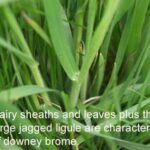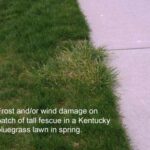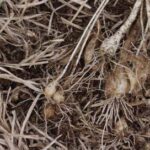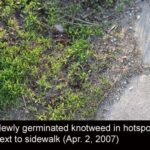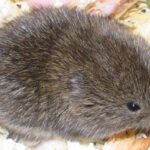Turf Tips Archives
Turf Field Day
Mark your calendar for the 2007 Turf Field Day at the W.H. Daniel Center in West Lafayette on July 17, 2007. Come see the most up-to-date research that the Purdue Turf Program is doing and don’t forget to pre-register to get the pork chop lunch! Registration forms will be sent out in early May.
Downy brome growing fast and furious in turf stands
The winter annual downy brome is growing aggressively in turf stands currently, almost twice as fast as the desired Kentucky bluegrass or tall fescue (photo). Downey brome is fairly easily identified at this time of the year by its hairy leaves and sheaths and it has a split collar with jagged membranous ligule (photo). It […]
Purdue Turfgrass Research Report Available On-Line
The summary of our turfgrass research in the year 2006 is now available at http://www.agry.purdue.edu/turf/report/2006/index.htm. The overall goal of our research program is to minimize inputs while maintaining turf quality, minimizing costs, and further protecting our environment. Our research summary contains over 40 reports of on-going research at Purdue University . The report is a cooperative […]
Effect of cold snap on turf?
The recent cold snap should have little long term effect on the turf portion of the landscape. Our cool-season grasses are more than capable of withstanding weather like this, though newly emerged seedlings may suffer some damage from the cold and/or wind. Wind or desiccation damage may also be seen on fast growing tall fescue […]
Controlling Wild Onion or Wild Garlic
Wild onion and wild garlic are now fully emerged throughout the state of Indiana and these are two of the more difficult to control weeds. Like the garden varieties, these plants are edible and similar looking, except the stems of the wild type are much thinner and do not grow as tall as the garden […]
Do-It-Yourselfer: Is it Crabgrass or Tall Fescue?
We have received a number of calls this year about trying to control the crabgrass running rampant in lawns. It’s a much more coarse bladed and lighter green than the rest of the grass, so it must be crabgrass? It’s not crabgrass and is more likely tall fescue. Though crabgrass and tall fescue may look […]
Star of Bethlehem , Spring Beauty Emerging in Shaded Areas
Star of Bethlehem and Spring Beauty are currently emerging and flowering in shaded areas in southern and central Indiana . Both plants have pretty white flowers with the Star of Bethlehem having six petals while Spring Beauty has only five petals. The Star of Bethlehem was once planted as an ornamental while the […]
A New Threat to Indiana Turfgrass: Two Species of Invasive Scarab Beetles (White grubs) Found in Northern Indiana
It was just a matter of time. While invasive species such as the emerald ash borer have been garnering so much attention in the press, the Turfgrass Entomology and Applied Ecology Laboratory at Purdue University has been tracking the spread of three additional species of invasive, turfgrass infesting white grubs (European chafer, Asiatic garden beetle […]
If You Must Seed, Do it Now
Late summer (August) is easily the best time to seed cool-season grasses, but sometimes turf must be seeded in the spring. The following points should help improve the success of spring seeding: 1. Seed as soon as possible (now is not too early) so the seed is in the ground and ready to germinate as […]
Timing of Preemergence Herbicides: Part 2
With the above average temperatures over the last few weeks, many questions have arisen again about when to apply the preemergence herbicide for crabgrass. As mentioned in the February 20 edition of Turf Tips, it is much better to apply early rather than late. It is still not too late to apply preemergence herbicide as […]
Knotweed germinating next to sidewalks and other hotspots
Prostrate knotweed is currently germinating in thin areas next to sidewalks, cart paths, driveways and other hotspots. Knotweed is often confused with crabgrass at this early stage. Knotweed leaves have rounded leaf tips whereas crabgrass has leaf tips that come to a dull point (See photos). Crabgrass also has veins running lengthwise (parallel veination) whereas […]
Voles (remember the V)
During late March and April we get many calls about voles and vole damage in turfgrass. Voles are among the most important vertebrate pests in turf areas. Unfortunately the name ‘vole’ is very close to the name ‘mole’ causing some confusion and miscommunication. Even though both can damage turfgrass – the differences between voles and […]
GCSAA’s Nutrient Use Survey
GCSAA’s nutrient use survey is now available and may have already arrived on GCSAA members desks. This survey will help document changes in cultural practices over time as well as help direct GCSAA research, and allow the GCSAA to respond to inquires on environmental and regulatory issues. Completing the survey will help provide the GCSAA […]
Tracking Growing Degree Days
Many of our pest problems in turf can be at least partially predicted through growing degree day models ( Poa annua seedheads is one example). Most of the models use a base temperature of 50 (abbreviated as GDD 50 ) assuming 50 degrees is the temperature when most of our biological activity starts occurring. GDD50 for IN […]
Fire up the Mower!
Now’s the time to get the mower out of the shed and start mowing (depending on where you live in the state). This normally happens well before most of us start mowing because we see mostly brown leaf blades and we don’t think the lawn is growing. However, grass plants grow from the bottom up […]
Control of Quackgrass in Turf
I have received a number of calls recently about controlling quackgrass in turf. Quack is difficult to control because it spreads by deep rhizomes and herbicides do not translocate well through the rhizomes. The current best method is with 3-4 applications of glyphosate spaced 3-4 weeks apart followed by reseeding in early August. Do not […]
Choose Preemergence herbicides with as Little N as Possible
If a preemergence herbicide is justified on your lawn to control crabgrass now, most of those are available combined with fertilizer and you are forced to apply a fertilizer now. Look for a product with low nitrogen and be sure the majority of the nitrogen is a slow release N. Slow release sources include sulfur- […]
Earthworms Activity in Lawns
Earthworm activity is on the rise as soils warm up, but their mounds will be highly visible until grass starts growing in late March and April. Earthworms are highly beneficial because they create channels for air and water penetration, reduce thatch, and tend to increase the fertility and health of a soil. However, some will […]
Choosing a Preemergence Herbicide
There are many, many formulations and combinations of preemergence herbicides available for the professional. Following are some suggestions for purchasing and using preemergence herbicides. Control from every preemergence herbicide can vary from year to year, or location to location. Therefore, you can’t judge the performance of a product or a specific rate of that product […]
Calculating the pounds of fertilizer to apply
There are literally thousands of fertilizers and fertilizer/pesticide combinations available to homeowners and professionals. Therefore, we can’t recommend how many pounds of a specific fertilizer to apply, but rather we must recommend fertilization rates in pounds of nitrogen per thousand square feet or lbs N/1000 sq ft. You can use our fertilizer calculator at http://www.agry.purdue.edu/turf/fertcalc/Fertilization%20calc.html or you […]
